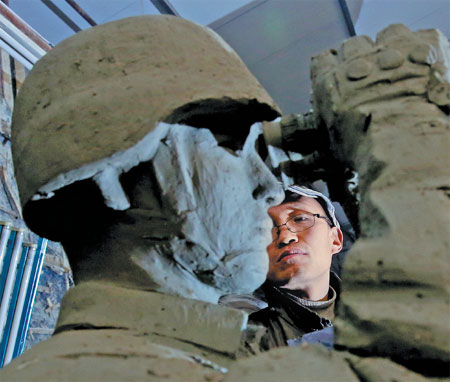

Craftsmen in Beijing's art zones work hard to develop their trade despite a struggling global economy.
In a factory workshop in northeast Beijing's Heiqiao art zone, a group of workers has nearly finished a set of clay sculptures, including three 5.5-meter-high horses and a giant statute of Genghis Khan.
Zhang Bao, 31, with his blue jacket spattered with clay, uses a laser pointer to direct his workers climbing on the iron supports around the statues.
The artworks are for a local government sector of the Inner Mongolia autonomous region - once the cradle of Genghis Khan's formidable empire.
The contract price of the sculptures is about 10 million yuan ($1.6 million), but Zhang and his team will only get a tiny slice of the pie.
The heating system in the workshop doesn't work. The only heat is from a coal stove.
"It is to prevent the clay from being frozen, not for our warmth," Zhang says. The quality clay is more expensive than flour, he adds.
The sculptures will consume eight tons of clay. The final process will be to cast copper on the surface after the clay work is done.
Beijing is a major hub where thousands of sculptures are assembled in "art zones". Most are in abandoned factories and suburban villages, such as Heiqiao, 798 art zone and Songzhuang village.
China's urbanization has sparked demand for urban sculpture. Major clients include local governments, the tourism industry and real-estate developers who want to attract and impress customers.
A father of two, Zhang has a no-job-too-small approach to his work, from an 18-meter-tall statue to small Angry Birds models. He can make 200,000 yuan ($32,600) in a good year.
Zhang says a worker on his team earns about 7,000-10,000 yuan a month - more than many white-collar jobs pay in Beijing.
But since last year the business has slowed. The anti-graft campaign, launched by the central government, has meant some industries that profited from abuses of public money have been affected, including the sculpture makers.
"If it is an industrial chain, we belong to the bottom part, and we are affected seriously," says Zhang, who learned the art in his hometown, Quyang county in Hebei province.
Quyang is famous for its traditional stone-carving culture that dates back more than 2,000 years. Stone cutters from Quyang have played important roles in the construction of modern China's major projects like the Great Hall of the People and Chairman Mao Memorial Hall.
The local products, such as ornate white marble statutes, busts and fountains, are popular exports among buyers in Europe and North America.
But the global economic slump has affected Quyang's art exports in recent years. Like many young sculptors, Zhang left his hometown to seek opportunities in Beijing in 2008. He switched from stone-cutting to clay sculpture after realizing that dust could kill people.
"Most sculptors like me received little education. I think we lack the inspiration and creativity compared to the masters," Zhang says. "Just like in every business, you have to need connections in the market, but only the top players can access resources."
The "top players" in the industry are those national-level sculpture masters and professors from colleges like the China Central Academy of Fine Arts and the Academy of Art and Design of Tsinghua University.
Zhang is planning to return to his hometown. "I feel unstable and stressed in Beijing," he says.
"I am an artist, not a laborer. When I have enough money, I will make my own sculptures."
Major clients usually ask for works from the hands of renowned sculptors, who usually do the designs and then contract the production to teams like Zhang's.
Wang Shushan, 40, a graduate of the Academy of Art and Design of Tsinghua University, has his own studio and company. He and his assistants are working on a set of military-themed sculptures, including a statue based on the crew from China's first aircraft carrier.
Wang doesn't worry much about the downturn, insisting that people will always need beauty to appreciate and memorials of things they cherish. "The problem is that there are too many poor pieces of sculpture everywhere that blemish the reputation of the art and landscapes of cities," he says.
Despite the recent downturn, the booming sculpture industry in China keeps attracting masters and artists from abroad.
Wang Jida, 79, graduated from the China Central Academy of Fine Arts in the 1960s and took part in the sculpture project of the Chairman Mao Memorial Hall.
In 1983, he went to New York and became one of the first Chinese artists who exhibited abroad. He is a fellow of the National Sculpture Society of the United States.
"A sculptor cannot make a good living until his or her work is acknowledged by collectors. It is the same everywhere," Wang says.
He travels back to China every year. His current 10-day solo exhibition at the National Art Museum of China in Beijing opened on March 5.
"We have been doing many things too fast. Many works like sculptures require time and patience," Wang says.
Copyright ©1999-2018
Chinanews.com. All rights reserved.
Reproduction in whole or in part without permission is prohibited.